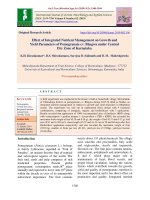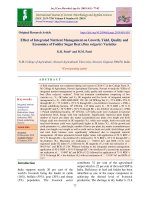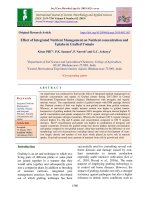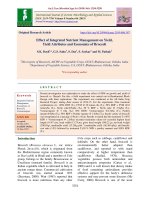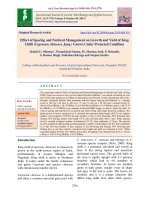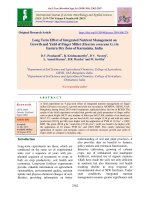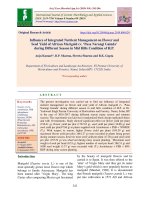Effect of integrated nutrient management on productivity and nutrients availability of potato
Bạn đang xem bản rút gọn của tài liệu. Xem và tải ngay bản đầy đủ của tài liệu tại đây (190.58 KB, 8 trang )
Int.J.Curr.Microbiol.App.Sci (2017) 6(3): 1429-1436
International Journal of Current Microbiology and Applied Sciences
ISSN: 2319-7706 Volume 6 Number 3 (2017) pp. 1429-1436
Journal homepage:
Original Research Article
/>
Effect of Integrated Nutrient Management on Productivity
and Nutrients Availability of Potato
Pradip Kumar1, Alok Kumar1, Neeraj Kumar1, Atik Ahamad1* and M.K. Verma2
1
Department of Soil Science and Agricultural Chemistry NDUAT Kumarganj, Faizabad,
Uttar Pradesh- 224229, India
2
Department of Soil Science and Agricultural Chemistry, IAS, BHU, Varanasi, Uttar Pradesh221005, India
*Corresponding author
ABSTRACT
Keywords
Growth, Available
nutrient,
Economics, Potato.
Article Info
Accepted:
22 February 2017
Available Online:
10 March 2017
A field experiment was conducted at Agronomy Research Farm of N.D.U.A.&T.
Kumarganj, Faizabad, during the Rabi season of 2012-13 to assess the growth, yield and
nutrient availability as affected by integrated nutrient management of potato crop. The
twelve treatments comprised with various levels of Tata Geo Green (as well matured
compost prepared from byproducts of sugarcane industry) and Farm Yard Manure with
75% and 100% NPK fertilizers were tested against 100% fertilizers alone. Application of
integrated use of Tata Geo Green @ 3.75 t/ha along with 75% recommended dose of NPK
fertilizer (150:60:100) in potato was found superior for higher plant growth. The
availability of N, P, K nutrients and organic carbon in soil increased at higher rate by
applying TGG and FYM along with fertilizers as compared to chemical fertilizers alone.
The application of Tata Geo Green @ 3.75 t/ha along with 75% recommended dose of
chemical fertilizers provided highest net returns (Rs.133205) and Rs. /Re invested (1.34).
It was concluded that application of TGG @ 3.75 with 75% RDF may be recommended
for higher productivity and returns.
Introduction
Potato is the fourth most important food crop
after rice, wheat and maize in the North-East
plains of India. India is the second largest
potato producing country in the world after
China, with annual production of 42.48
million tonnes from area of 1.93 million
hectare, while in Uttar Pradesh area,
production and productivity of potato is 0.55
m ha, 13.57 m tonnes and 24.67 tonnes ha-1,
respectively (Anonymous, 2013). Being a
heavy feeder of nutrients, potato required high
amount of nitrogen, phosphorus and potassium.
Chemical fertilizer is the main source of
nutrients use for potato cropping. However,
continuous dependence of chemical fertilizer
causes nutritional balance and adverse effects
on physic-chemicals and biological properties
of soil. Integrated nutrient management is a
bitter approach for supplying nutrient or food
to the crop by including organic and inorganic
source of nutrient (Arora, 2008). Further
imbalance and indiscriminate use of chemical
fertilizers and pesticides resulted several
harmful effects on soil, water and air causing
1429
Int.J.Curr.Microbiol.App.Sci (2017) 6(3): 1429-1436
their pollution. This has reduced the
productivity of the soil by deteriorating soil
health in terms of soil fertility and biological
activity. Excessive use of agrochemicals
under intensive cultivation has disturbed the
harmony which existed among soil, plant,
biolife, animals and human beings. Thus,
integrated approach of nutrient supply by
chemical fertilizers along with organic
manures is giving an importance especially in
heavy feeder crops. Further, considerable
improvement in quantity and quality of
exhaustive and responsive crop like potato
has been observed under integrated use of
organic and inorganic fertilizers as compared
to recommended dose of nutrients applied
with inorganic fertilizers alone (Raghav et al.,
2009 and Bhaishya et al., 2012).
Materials and Methods
The field experiment was conducted during
Rabi season in 2012-13 at Agronomy
Research Farm of NDUA&T Kumarganj,
Faizabad (U.P.). It lies at 260 47' N latitude,
820 12' E longitude and an altitude 113 m
above the mean sea level. The available N, P
and K content of the soil were 114.0, 13.5 and
246.0 kg ha-1, respectively with bulk density
1.38 (Mg m-3), pH 8.30, EC 0.33 (dSm-1) and
OC-0.40%. Tata geo green free from weed
seeds and disease causing microbes, having 2
to 2.5% nitrogen, 4% phosphorus, 3%
calcium, 1% magnesium 1.25% sulphur, 100
ppm zinc and 300 ppm manganese and other
micronutrients e.g. Cu, Bo, Fe. It also
contains organic matter 30% of biomass, pH
6.5 to 7.5 and organic carbon 18-21%.
There were twelve treatment combinations
viz. T1- TGG 2.5 t ha-1 +100% RDF, T2 TGG 3.75 t ha-1+100% RDF, T3- TGG 5t ha1
+ 100% RDF, T4- TGG 2.5 t ha-1 +75%
RDF, T5- TGG 3.75 t ha-1 + 75 % RDF,T6TGG 5 t ha-1 +75% RDF, T7- FYM 12.5 t ha-1
+ 100% RDF, T8- FYM 25 t ha-1 + 100%
RDF , T9- FYM 12.5 t ha-1 +75%RDF, T10 FYM 25 t ha-1 75% RDF, T11- 100% RDF and
T12- Control were replicated thrice in a
Randomized Block Design. Potato variety
Kufri Lalima was used in this study. In
addition to this, half quantity of nitrogen and
full quantity of phosphorus and potassium
were also applied as per treatment through
urea, diammonium phosphate and muriate of
potash, respectively. The remaining half
quantity of nitrogen was top dressed in
furrows at the time of earthing up. Potato
tubers were planted in the ridge 45 cm apart
with plant to plant distance of 10 cm in the
November, 2012.
All the growth parameters were studied, plant
height was measured from the base of the
plants to the apex at 45 and 60 DAP, number
of haulms per hill was counted at 60 days
after planting. The yield parameters were
collected at harvest i.e. 120 days after
Planting. For determining specific gravity, the
tubers of each grade were taken randomly
from each plot. Tubers were weighed
separately and then they were placed into
measuring cylinder containing water. Thus,
water which was replaced by the tubers was
measured and specific gravity was calculated
adopting the following formula:
Specific gravity =
Weight of tubers (g)
-------------------------------------------------x 100
Volume of water replaced by the tubers (ml)
Chemicals analysis
Chemical properties of organic carbon was
determined by Walkey and Black (1934),
available N by alkaline Potassium
Permanganate method (Subbiah and Asajia,
1956), available P by Olsen’s method (Olsen
et al., 1954) and available K by Ammonium
Acetate Extraction method (Jackson, 1973).
1430
Int.J.Curr.Microbiol.App.Sci (2017) 6(3): 1429-1436
Statistical analysis
Number of haulms hill-1
The analysis of variance methods (Snedecor
and Cochran, 1967) was followed to
statistically analyze the various data. The
significance of different sources of variations
was tested by Error mean square of Fisher
Snedecor’s ‘F’ test at probability level (P =
0.05). In the summery tables of the results, the
standard error of mean (Sem ±), the value of
critical difference (CD) and coefficient of
variation (CV) to compare the difference
between the means have been provided.
The number of haulms/ hill at 60 days after
planting (DAP) has been given in (Table 1)
number of haulms hill-1 were not influenced
significantly due to application of various
doses of Tata geo green (2.5, 3.75 and 5 t ha1
) and farm yard manure (12.5 and 25 t ha-1)
along with 75 and 100% chemical fertilizers
alone as compared to 100% recommended
chemical fertilizers alone. The maximum
number of haulms hill-1 (5.26) was recorded
in the treatment receiving farm yard manure
25 t + 75% RDF (T10), which remained at par
to all the manure treatments (T1 to T9 and T11)
in which the number of haulms hill-1 varied
from 4.90-5.26.
Results and Discussion
Plant height (cm)
Highest plant height was recorded at 45 days
after planting with TGG 5t ha-1+ 100% RDF,
which was significant higher than other
treatments combination. The data showed that
60 DAP about 10-14 cm increase in plant
height during 15 days (45 to 60 DAP) (Table
1). The maximum plant height (49.2cm) was
recorded with treatments T6 receiving TGG @
5 t ha-1 along with 75% RDF, which was
remained at par to all the integrated nutrient
management treatments receiving various
levels of TGG (2.5, 3.75 and 5 t ha-1) and
FYM (12.5 and 25 t ha-1) along with 75% and
100% RDF or 100% RDF alone. Plant height
recorded at 45 days after planting (DAP)
revealed that there was no significant
difference among the treatments receiving
various levels of Tata geo green (2.5, 3.75 and
5 t/ha) and farm yard manure (12.5 and 25
t/ha) along with 75 % and 100%
recommended doses of NPK fertilizers (RDF)
or 100% RDF alone. Pandey et al., (2008)
studied the various options of nutrient
management in potato and reported that plant
growth parameters (plant height) remains
unaffected up to 50% replacement of
inorganic by organics sources but yield
decreased significantly.
Haulms (q ha-1)
The results showed (Table 1) significant
variation in haulms production due to the
different nutrient management practices. The
highest haulms production was obtained with
the application of FYM 25 t ha-1 + 100%
RDF, but it was statistically at par with
treatment T3, T6 and T2. The application of
organic manures viz., TGG and FYM along
with chemical fertilizers increased haulm
(plant biomass) production significantly
compared to chemical fertilizers alone. The
increase in dose of FYM (12.5 to 25 t ha-1)
and Tata geo green (2.5 to 5.0t/ha) also
increased haulm production significantly
similarly reported by Krishnamurthy et al.,
(2002).
Specific gravity (g cm-3)
Specific gravity of tubers increased
significantly by applying organic manures
viz., Tata geo green and farm yard manure
along with 75% and 100% recommended
dose of NPK fertilizers as compared to 100%
RDF alone. However, no significant
variations were observed among the various
1431
Int.J.Curr.Microbiol.App.Sci (2017) 6(3): 1429-1436
levels of organic manures (FYM and TGG).
Similar results have been reported by Mandal
et al., (2005); Gauhar and Raghav (2008) and
Bhaishya et al., (2012).
Total Tuber Yield (q ha-1)
The pooled yield data showed that application
of Tata geo green and farm yard manure
along with chemical fertilizers increased the
total tuber yield significantly as compared to
100% chemical fertilizers alone (Table 1).
Presence of plant growth influencing
substances such as plant growth hormones
and humic acid and organic manures might be
a possible factor contributing to increase yield
(Das et al., 2002). The increasing level of
TGG from 2.5 t/ha to 3.75 t /ha increased the
tuber yield significantly, but further increase
in the dose of TGG (3.75 to 5t/ha) was not
resulted a significant increase in tuber yield at
both the levels of chemical fertilizers (75%
and 100%). Similarly, the increase in the dose
of FYM from 12.5 to 25t ha-1 increased total
tuber yield significantly at both the levels of
recommended doses (75% and 100%) of
fertilizers. Among the organic sources, Tata
geo green was found more responsive than
farm yard manure in terms of productivity of
tubers.
Table.1 Effect of integrated nutrient management on plant height at 45 and 60 days after
planting
Plant
height (cm)
Treatment
T
TGG
T
TGG
T
1
2.5
+ 100% RDF
+ 100 %RDF
45
60
DAP DAP
36.1 46.8
Number
of
haulms
/ hill
60 DAP
Haul
ms
(q/ha)
Specific
gravity
(g/ cm )
Total
Tuber
Yield
4.96
96.4
1.05
282
3
37.2
47.9
4.90
99.9
1.05
292
TGG + 100% RDF
37.8
48.4
5.15
101.7
1.06
297
T
TGG
36.4
47.6
5.00
95.3
1.05
276
T
TGG
37.0
47.6
5.20
98.4
1.06
291
T
TGG +75% RDF
35.9
49.2
4.90
100.5
1.06
293
T
FYM
37.4
47.5
5.00
96.8
1.05
268
T
FYM
+100% RDF
38.4
48.3
5.20
102.4
1.06
281
T
FYM
+75%RDF
36.9
45.9
4.90
93.4
1.05
254
T
FYM
+75% RDF
35.7
46.7
5.26
97.2
1.06
270
T
100% RDF
36.0
46.5
5.10
88.8
1.03
248
T
Control
32.4
0.94
2.8
38.2
1.1
3.3
4.38
0.16
0.45
58.5
1.26
3.60
1.02
0.006
0.018
158
3.00
8.70
2
3
4
5
6
7
8
9
10
11
12
3.75
5
2.5
+75% RDF
3.75
+ 75 % RDF
5
12.5
SEm±
CD at 5%
25
12.5
25
+ 100 % RDF
1432
Int.J.Curr.Microbiol.App.Sci (2017) 6(3): 1429-1436
Table.2 Effect of integrated nutrient management on nutrients availability after harvest of potato
Treatment
Available N
(kg/ha)
148
Available P
(kg/ha)
18.5
Available K
(kg/ha)
148
0.59
153
19.8
153
T
TGG
T
TGG
T
TGG + 100% RDF
0.60
160
22.0
160
T
TGG
0.55
143
16.8
143
T
TGG
0.58
148
18.5
148
T
TGG +75% RDF
0.60
155
19.4
155
T
FYM
0.54
148
18.9
148
T
FYM
+100% RDF
0.58
156
21.2
156
T
FYM
+75%RDF
0.53
144
17.8
144
T
FYM
+75% RDF
0.57
152
20.1
152
T
100% RDF
0.49
134
17.2
134
T
Control
0.42
118
13.0
118
SEm±
CD at 0.05%
0.01
0.03
3.17
9.2
0.62
1.8
3.17
9.2
1
2
3
4
5
6
7
8
9
10
11
12
2.5
+ 100% RDF
O.C.
(%)
0.56
3.75
+ 100 %RDF
5
2.5
+75% RDF
3.75
+ 75 % RDF
5
12.5
25
12.5
25
+ 100 % RDF
Table.3 Economics of potato cultivation influenced by various nutrient combinations
T1
226400
Total cost of
cultivation
(Rs/ ha)
96260
129340
BCR (Rs/
Re
invested)
1.34
T2
233600
101260
132340
1.31
T3
237600
106260
131340
1.24
T4
220800
94595
126205
1.33
T5
232800
99595
133205
1.34
T6
234400
104595
129805
1.24
T7
214400
94385
120015
1.27
T8
224800
102510
122290
1.19
T9
203200
92720
110480
1.19
T10
216000
100845
115155
1.14
T11
198400
86260
112140
1.30
T12
126400
79600
46800
0.59
Gross income (Rs/
Treatment
ha)
1433
Net income (Rs
/ha)
Int.J.Curr.Microbiol.App.Sci (2017) 6(3): 1429-1436
Raghav et al., (2009) reported maximum
tuber yield of potato (270 q ha-1) under the
treatment receiving combinations of organic
manures
(FYM,
poultry
manure,
vermicompost) which was 7.0% higher than
100% recommended doses of chemical
fertilizers. Similar observations have also
been noted by Singh et al., (2008) and Islam
et al., (2013).
Effect on soil nutrient status after harvest
The data recorded on soil properties as
influenced by various treatments have been
given in table 2. Significantly higher values of
organic carbon percentage, available N, P2O5
and K2O content in soil were recorded in
application of T3- TGG 5t ha-1+ 100% RDF.
The organic carbon also increased
significantly with increasing doses of TGG
from 2.5 to 5 t/ha and FYM from 12.5 to 25
t/ha at both the levels (75% and 100%) of
chemical fertilizers. This could be attributed
to direct addition of organic substances in soil
and due to better root growth, more plant
residues after crop harvest and their indirect
influence on physico-chemical characteristics
of the soil (Kaushik et al., 1984 and Ojha et
al., 2009).
It was also observed that available nitrogen
increased significantly with increasing levels
of TGG from 2.5 to 5t/ha. The increase in
available nitrogen with increasing doses of
FYM from 12.5 to 25t ha-1 was also noticed
but not to the extent of significance. The
increase in soil nitrogen might be due to
direct addition of N through fertilizer and
organic materials and greater multiplication of
soil microbes, which converts organically
bound nitrogen to inorganic form (Bellakki
and Badanur, 1997). Manjappa (1999) also
founded that inclusion of organic manures
such as FYM, vermicompost, cotton and
safflower stalk enhanced the soil available
nitrogen more as compared to recommended
dose of fertilizers alone.
The application of higher quantity of Tata geo
green (5t ha-1) and farm yard manure (25t ha-1)
along with chemical fertilizers increased
available
phosphorus
significantly as
compared to 100% chemical fertilizers alone.
Selvamani et al., (2011) reported that
phosphorus content in soil increased the
significantly by application of organics and
bio-inoculants in rice. Organic acids released
during decomposition of organic manures
increased availability of phosphorus. The
organic materials form a protective cover on
sesquoxide and thus also reduce the
phosphate fixing capacity of soil and hence,
increase available P status of soil (Singh et
al., 2006). The significant build up in
available potassium was recorded with
increasing levels of TGG from 2.5 to 5.0 t/ha.
The application of Tata geo green increased
more potassium than farm yard manure.
The application of organic manures (Tata geo
green and farm yard manure) along with the
chemical fertilizers increased available
potassium significantly as compared to 100%
chemical fertilizers alone. The significant
build up in available potassium was recorded
with increasing levels of TGG from 2.5 to 5.0
t/ha. The application of Tata geo green
increased more potassium than farm yard
manure. The organic manures have greater
capacity to hold K in available form and
reduced K-fixation due to interaction of
organic matter with clay besides direct
addition of potassium to the available pool of
soil (Mathur, 1997). Selvamani et al., (2011)
reported maximum potassium content in soil
with application of 50% RDF through
inorganic
fertilizers
with
FYM,
vermicompost, neem cake and biofertilizers.
Economics
The data (Table 3) revealed that maximum net
return (Rs. 133205 /ha) and benefit-cost ratio
(1.34 Rs per Re invested) were obtained by
applying Tata geo green @ 3.75 t ha-1 along
1434
Int.J.Curr.Microbiol.App.Sci (2017) 6(3): 1429-1436
with 75% recommended dose of chemical
fertilizers. The application of TGG with
fertilizers provided higher net returns as
compared to FYM with fertilizers. The
chemical fertilizers alone also provided higher
benefit-cost ratio (Rs. 1.30 Rs per Re
invested) as compared to 5 t TGG ha-1, 12.5 t
FYM ha-1 and 25 t FYM ha-1 along with
fertilizers, similarly reported by (Chettri and
Thapa, 2004).
In conclusion, the integrated use of Tata geo
green @ 3.75 t/ha along with 75%
recommended dose of NPK fertilizer
(150:60:100) in potato was found superior
and recommended for higher productivity and
better marketable quality of tubers. The
integrated application of Tata geo green
@3.75 t/ha along with 75% recommended
dose of chemical fertilizers provided
maximum net returns and Rs per Re invested
(benefit-cost ratio).
References
Annonymous. 2013. Estimates of potato
production, Directorate of Economics.
Ministry of Agriculture, New Delhi.
Arora. 2008. Balance nutitional for
sustainable crop production. Krishi
world, 1-5.
Baishya, M.K., Ghosh, L.K., Gupta, D.C.,
Dubey, V.K., Anup, S.K. and Patel,
D.P. 2012. Productivity and soil health
of potato (Solanum tuberosum L.) field
as influenced by organic manures,
inorganic fertilizers and biofertilizers
under high altitudes of Eastern
Himalayas. J. Agril. Sci., (Toronto);
4(5): 223-234.
Bellakki, M.A., and Badanur, V.P. 1997.
Long-term effect of integrated nutrient
management on properties of Vertisol
under dryland agriculture. J. Indian Soc.
Soil Sci., 45: 438-442.
Chettri, M., and Thapa, U. 2004. Integrated
nutrient management with farm yard
manure on potato (Solanum tuberosum)
under gangetic plains of West Bengal.
Environ. Ecol., 22(4): 766-769.
Gauhar, S., and Raghav, M. 2008. Effect of
integrated nutrient management on yield
and quality of potato (Solanum
tuberosum L.). Pantnagar J. Res., 6(1):
122-124.
Islam, M.M., Majid, S.A., Jannatul, N.M., and
Ferdous Alam, M.S. 2013. Integrated
nutrient management for potato
(Solanum tuberosum) in grey terrace
soil (Aric Albaquipt). Australian J.
Crop Sci., 7(9): 1235-1241.
Jackson, M.L. 1973. Soil chemical analysis.
Prentice Hall of India. Pvt. Ltd. New
Delhi. 186-192,
Kaushik, R.D., Verma, K.S., Dang, Y.P.,
Sharma, A.P., Verma, S.I. and Pannu,
B.S. 1984. Effect of nitrogen and farm
yard manure on yield of crops, nutrients
uptake and soil fertility in paddy-wheat
rotation. Indian J. Agril. Res., 18: 7378.
Krishnamurthy, N., Abdul Khalak, Sujith, G.
M., Basavaraj, H.K., Prasanna, K.P.R.
and Shivaraj, B. 2002. Integrated
nutrient supply and management
(INSM) for potato production in
alfisols. Potato, global research &
development, Proceedings of the Global
Conference on Potato, New Delhi,
India, 6-11.
Manjappa, K. 1999. Sustainable production of
planted and ratoon crop of hybrid rice
under lowlands in hill zone of
Karnataka. Ph D. Thesis, University of
Agricultural Sciences, Dharwad.
Mathur, G.M. 1997. Effect of long-term
application of fertilizer and manures on
soil properties and yield under cotton
wheat
rotation
in
North-WestRajasthan. J. Indian Soc. Soil Sci., 45:
288-292.
Mondal, S.S., Debabrata Acharya, Arup
1435
Int.J.Curr.Microbiol.App.Sci (2017) 6(3): 1429-1436
Ghosh. and Bug, A. 2005. Integrated
nutrient management on the growth,
productivity and quality of potato in
Indo-Gangetic plains of West Bengal.
Potato J., 32(1/2): 75- 78.
Ojha, R.K., Mandal, B.K., Pareta, D.K. and
Thomas, T. 2009. Effect of combined
application of inorganic, FYM and
Azotobacter on chemical properties and
N, P, K availability after potato harvest.
Environ. Ecol., 27(4B): 1899-1902.
Olsen, S.R., Cole, C.V., Watanabe, F.S. and
Dean, L.A. 1954. Estimation of
available phosphorus in soils by
extraction with sodium bicarbonate.
U.S.D.A., Circular, 10: 939.
Pandey, P.K., Singh, S.K., Singh, S.V.,
Rawal, B.P. and Kumar, D. 2008.
Evaluation of nutrient management
options for potato processing cultivars.
Potato J., 35(1/2): 46-52.
Raghav, M. and Shashi, Kamal. 2009. Effect
of organic sources of nutrients on potato
production in Tarai region of
Uttarakhand, Pantnagar, J. Res., 7(1):
69-72.
Selvamani, P., Manivannam, K. and Mohan,
J. 2011. Impact of organic manures,
inorganic fertilizers and biofertilizers on
the nutrient concentration in soil at
different growth stages of banana cv.
Pooran Mysore. Plant Archives, 11:
1165-1168.
Singh, F., Kumar, R., Pal, S. and Kumar, P.
2006. Sustainable production of scented
rice (Oryza sativa) with manures and
biofertilizers. Ann. Agric. Res. New
Series, 27(4): 412- 413.
Singh, N.K., Kumar, Ashok. and Yadav, V.K.
2008. Integrated effect of organic and
inorganic fertilizers on yield and quality
of potato (Solanum tuberosum L.). Res.
Crops, 9(2): 338-341.
Snedecor, G.W. and Cochran, W.G. 1967.
Statistical method 6th Ed. Oxford and
IBH Publishing Corp, Calcutta.
Subbiah, B.V. and Asija, C.L. 1956. A rapid
procedure for the determination of
available nitrogen in soils. Curr. Sci.,
25: 259-260.
Walkely, A. and Black, A.I. 1934. Analysis of
organic carbon. Soil. Sci., 63-251.
How to cite this article:
Pradip Kumar, Alok Kumar, Neeraj Kumar, Atik Ahamad and Verma, M.K. 2017. Effect of
integrated nutrient management on productivity and nutrients availability of potato.
Int.J.Curr.Microbiol.App.Sci. 6(3): 1429-1436. doi: />
1436
